By default, WordPress displays your blog posts on the home page. However, if you are making a business website or simply want to customize your homepage, then you may want a separate page for your blog section.
This setup not only helps you keep your homepage clean and focused but also provides a dedicated space for readers to explore your blog content.
To improve the user experience and maintain a clear focus on our offerings, we have added separate blog pages on many of the websites of our partner companies, including WPForms, OptinMonster, and All in One SEO. This allows visitors to easily access blog content while prioritizing the primary goal of promoting our plugins.
In this article, we will show you two ways to create a separate page for blog posts in WordPress.
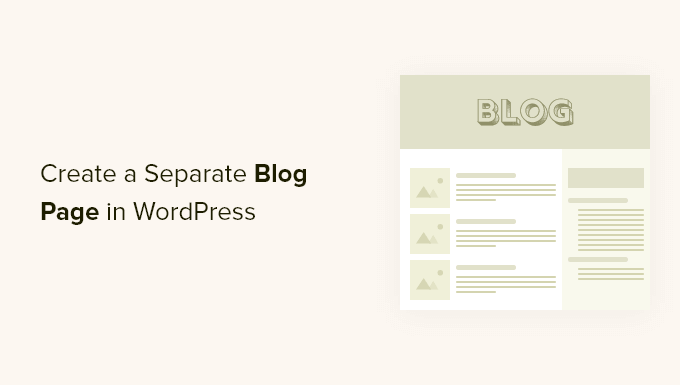
Why Display Blog Posts on a Separate Page?
The home page is the front page of your WordPress website and the first page your visitors see. By default, WordPress shows your most recent posts on your home page, and that makes sense if you are running a blog.
But it’s not always ideal for small business websites. You will probably want a more engaging home page that tells users about your business, products, and services, lets them know how to contact you, and boosts your sales conversion.
Now, if you also want to run a blog on your website, then you will need to provide another page where visitors can go to read your posts.
Having said that, we will show you how to easily create a separate page for blog posts in WordPress.
In this tutorial, we have discussed two methods, and you can use the links below to jump to the method of your choice. Keep in mind that the second method is the simplest and offers the most customization:
Video Tutorial
If you’d prefer written instructions, then just keep reading.
Method 1: Creating Separate Pages for Blog Posts in WordPress
You can create a separate page for blog posts using default WordPress settings.
However, this method takes a little more work than Method 2 and does not offer as many customization options.
Creating a Separate Home Page and Blog Page
First, you must create two separate WordPress pages to use as your home page and blog page.
You don’t need to add any content to those pages, and you can name them anything you like. For instance, some business websites use ‘News’ for their blog page.
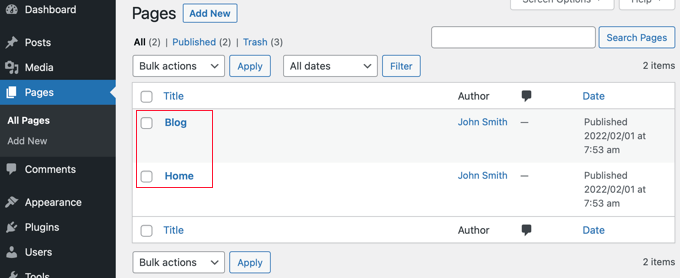
Once you have created those pages, visit the Settings » Reading page in the WordPress admin area.
Now, under the section labeled ‘Your homepage displays’, you need to click on the button for ‘A static page’.
After that, you can select the Home and Blog pages you created earlier. You should then scroll down and click the ‘Save Changes’ button.

Now, when you navigate to the Pages » All Pages screen from the WordPress dashboard, you will see that the Home page is labeled ‘Front Page’ and the Blog page is labeled ‘Posts Page’.
Go ahead and click on the ‘View’ link under the Blog page to preview it.
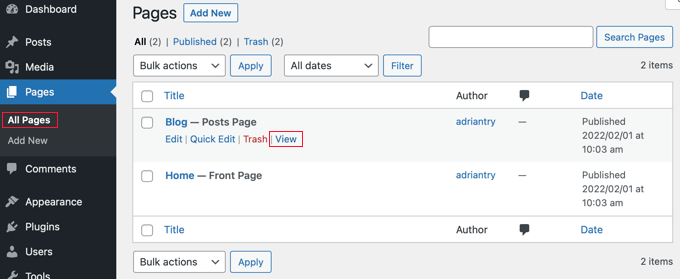
The appearance of these pages depends on your WordPress theme, and you may wish to configure these settings.
For example, if your theme has a navigation menu, then you will notice that WordPress has automatically added the new Blog and Home pages. If not, then refer to our beginner’s guide on how to add a navigation menu in WordPress.
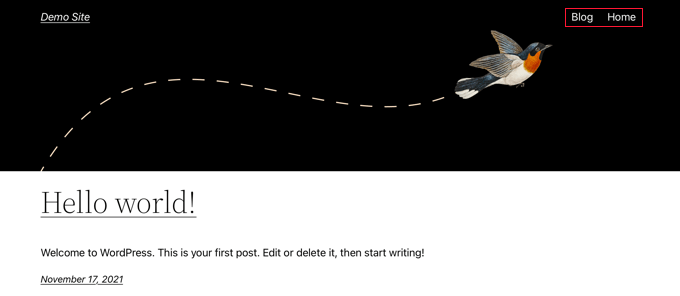
Customizing Your Home Page
So far, your new home page is blank. Now it’s time to add information about your business, products, and services and let your visitors know how they can contact you.
You can learn how to do that in our guide on how to create a custom home page in WordPress. In Method 1, we show you how to use the block editor to add cover images, columns, tables, text and media, galleries, and more.
You’ll also find lots of creative customization ideas in our guide on how to edit a WordPress home page easily and effectively.
Customizing Your Blog Page
If you’re happy with the way your blog page looks, then your job is finished.
However, if you are currently using a block-based theme, then you can also customize your blog page by visiting the Appearance » Editor screen from the WordPress dashboard.
Once you are there, select the ‘Pages’ option from the left column in the full site editor.
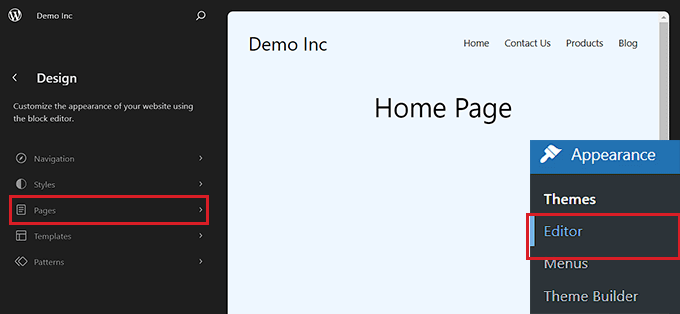
This will open a list of all the pages on your website in the left column.
From here, select the ‘Blog’ page option and then click on the page preview on the right to start customizing your blog page.
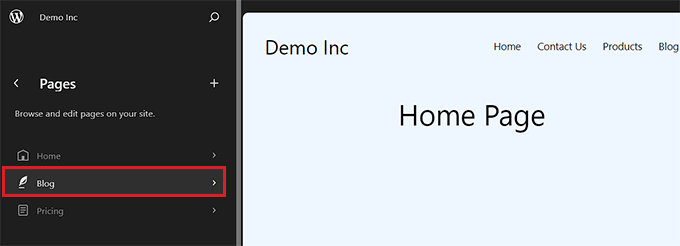
You can now click on the add block ‘+’ button in the top left corner of the screen and add blocks of your choice to the page.
Additionally, you can change the background, text, or link color on your blog page by clicking on the ‘Styles’ icon at the top right corner of the screen.
This will open a block panel on the right from where you can click the ‘Typography’ tab to change text color, the ‘Colors’ tab to change background color, and the ‘Layout’ tab to configure your blog page’s dimensions.
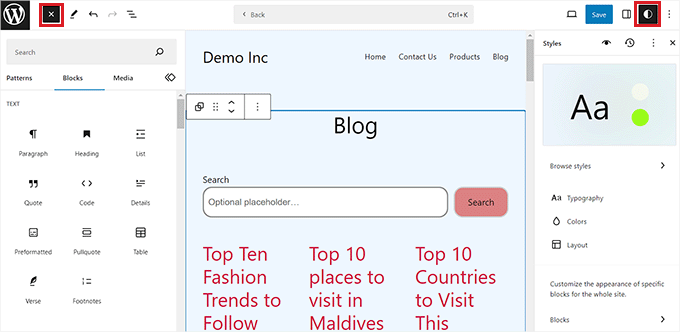
Once you are done, don’t forget to click the ‘Save’ button at the top to store your settings.
Now, you can visit your WordPress blog page to see how it looks.
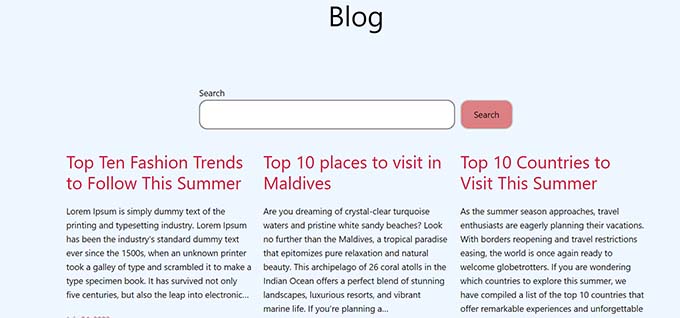
However, if you are using a classic theme, then you will need to use Method 2 instead to customize your blog post page.
Method 2: Creating a Customized Page for Blog Posts With a Drag & Drop Builder (Recommended)
A theme builder plugin allows you to easily create a custom WordPress theme without any code. That includes the ability to create and customize a separate page for blog posts.
Installing the SeedProd Theme Builder
First, you need to install and activate the SeedProd plugin. For more details, see our step-by-step guide on how to install a WordPress plugin.
SeedProd is the best drag-and-drop WordPress page builder for businesses, bloggers, and website owners. It also has a theme designer that allows you to easily customize your blog page and much more.
You can read our complete SeedProd review for more details.
Upon activation, visit the SeedProd » Settings page to enter your license key. You can find this information in your account on the SeedProd website.

After that, it’s time to create a custom WordPress theme. This is much simpler than it sounds.
Creating a Custom WordPress Theme
First, you need to visit the SeedProd » Theme Builder page. Here, you’ll use one of SeedProd’s ready-made themes as a starting point. This will replace your existing WordPress theme with a new, custom design.
You can do that by clicking the ‘Themes’ button.
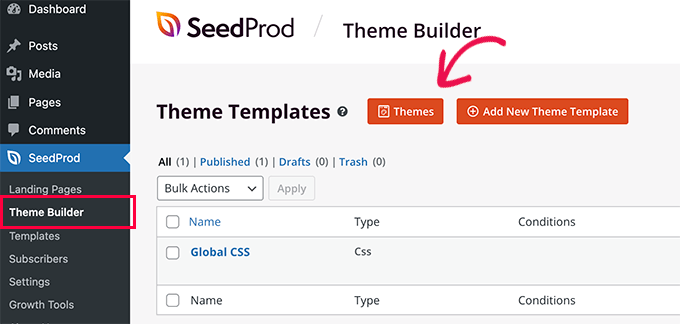
You will now be shown a list of professionally designed themes that are designed for different types of websites.
For example, there are templates called ‘Modern Business’, ‘Marketing Agency’, and ‘Mortgage Broker Theme’.
Have a look through the options and select one that best matches your needs by clicking the checkmark icon.
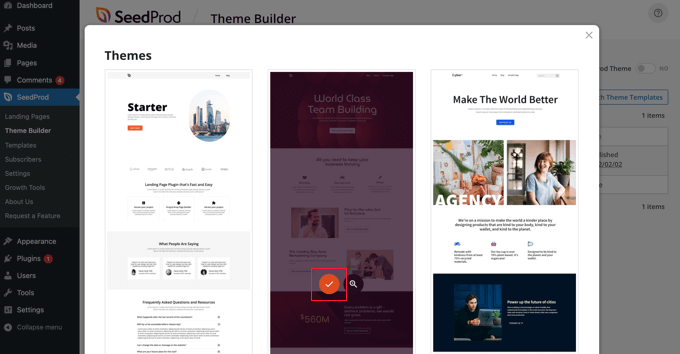
Once you have chosen a theme, SeedProd will generate all the theme templates, including one for your blog index and one for your home page.
These are not just empty pages but come set up with attractive layouts and placeholder content that’s easy to customize.
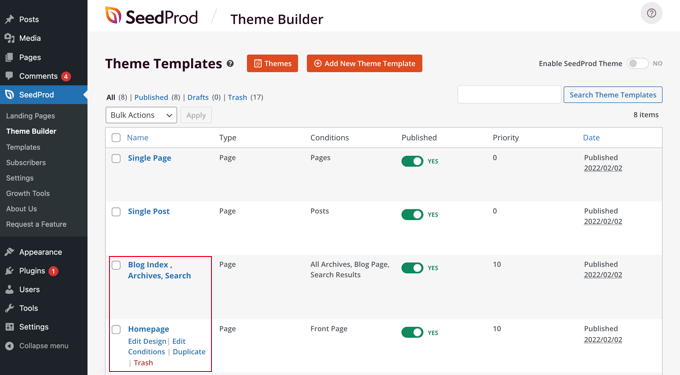
In this tutorial, we will show you how to customize the home page and blog index templates.
You might also like to customize the other templates. To learn how to do that, see our beginner’s guide on how to easily create a custom WordPress theme.
Customizing Your Home Page
Once you have generated your theme templates, you can edit them using the SeedProd theme builder. We will start with the Homepage template.
Simply click the ‘Edit Design’ link under the homepage to get started.

This will launch the template file in the SeedProd theme builder.
This simple drag-and-drop builder will show a live preview of your page to the right and a block toolbar on the left.
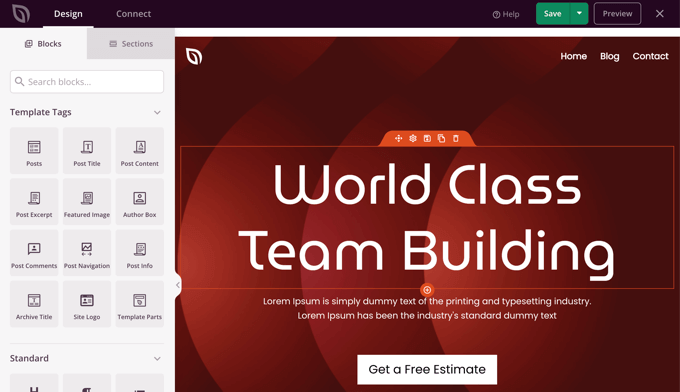
You can customize any block by clicking on it, dragging blocks up and down with your mouse, and adding new blocks to the page.
We’ve written a complete guide on how to create a custom home page in WordPress. Simply scroll down to Method 2 to learn how to customize your home page using SeedProd.
Customizing Your Blog Page
The SeedProd theme builder also provides plenty of ways to customize your blog index page.
Get started by clicking the ‘Edit Design’ link under the page.

You will see the same preview pane on the right and the toolbar on the left. You can customize the blog page the same way you did with the home page.
For example, when you click on the headline, you will be able to see all of its settings. You can edit the text, change the alignment and font size, and more.
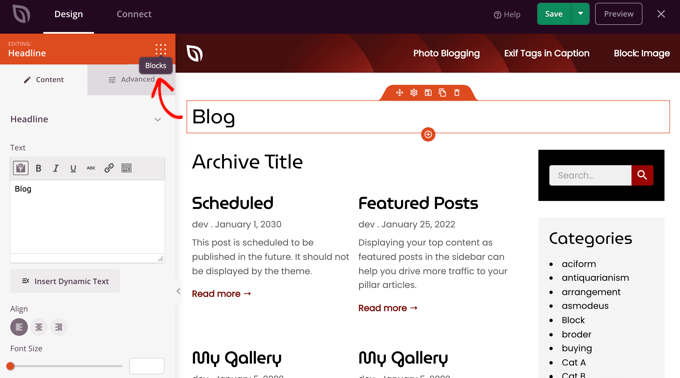
Once you’ve finished, you’ll need to click on the ‘Blocks’ icon to return to the toolbar.
The SeedProd theme builder offers additional Template Parts blocks, such as a Posts block, which displays a list of your blog posts.
The Posts block has already been added to the blog index template for you, and in this template, the block displays your posts in two columns. We can change this to a single column.
Simply click on the Posts block and then change the ‘Columns’ setting to 1.
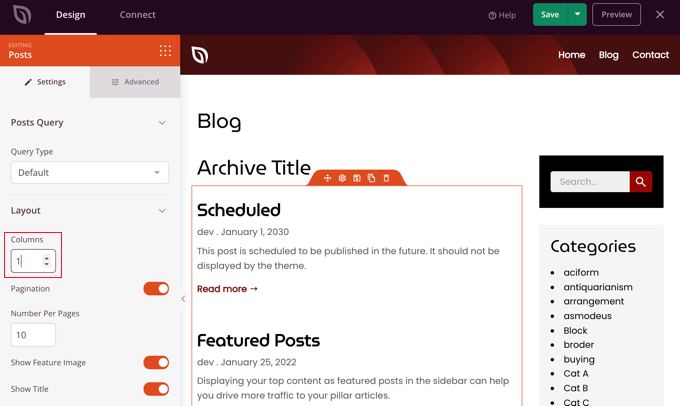
The layout will immediately change to a single column.
As you scroll down the Posts block settings, you’ll find toggle switches that let you choose whether or not to display the post’s feature image and title. You can also choose which header tag to use for the post title.
There are also options for displaying different post metadata. You can toggle the date modified, author, date and time published, and the comment count.
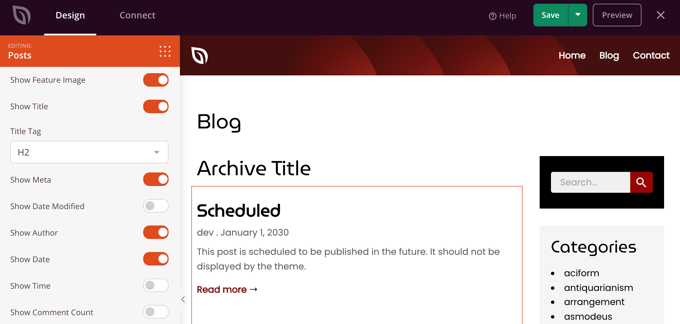
Here are a few more ways that you can customize your blog index:
- You can filter the index by post type, category, tag, or author.
- The sort order of the posts can be changed.
- You can choose how many posts are displayed on a page.
- You can toggle the post excerpt and customize its length.
Once you have finished customizing your blog page, make sure you click the ‘Save’ button at the top of the screen. Then, you can return to the list of templates by clicking the ‘X’ icon.
Enabling the SeedProd Theme
Once you have finished customizing the theme templates, you will need to publish the new custom theme.
Simply toggle the ‘Enable SeedProd Theme’ setting to the ‘YES’ position.
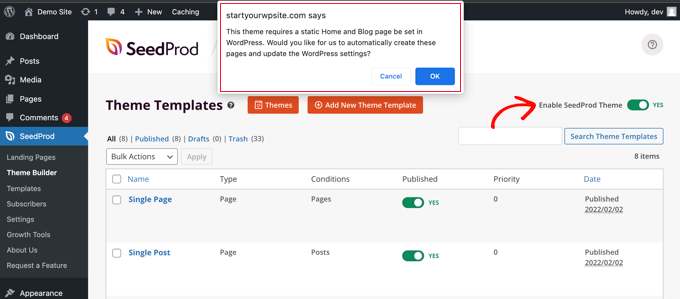
You will immediately see a notification that the WordPress Home and Blog page settings need to be changed. When you click the ‘OK’ button, these settings will be changed for you.
You can now visit your website to view your new home page and blog page. This is how the blog index page looks on our demo site.
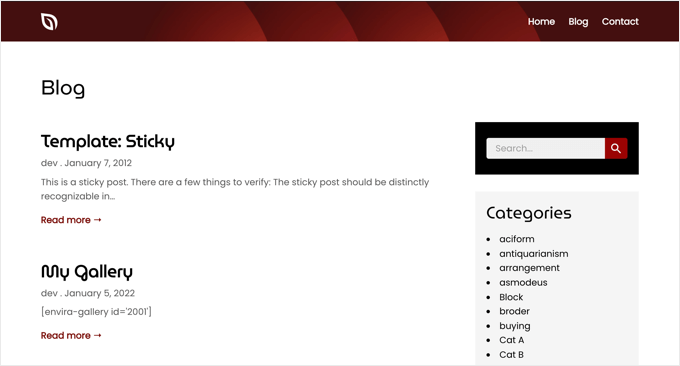
Bonus: Display Your Recent Posts in WordPress
Once you have created a separate blog page, you can still show some recent posts on your home page to encourage users to explore more of your site.
To do this, open your homepage in the WordPress block editor. Once you are there, click the ‘Add Block’ button at the top left corner of the screen to open the block menu.
From here, simply add the ‘Latest Posts’ block to the page. Once you do that, you can customize the list of recent posts to display post excerpts, author names, and dates according to your liking.
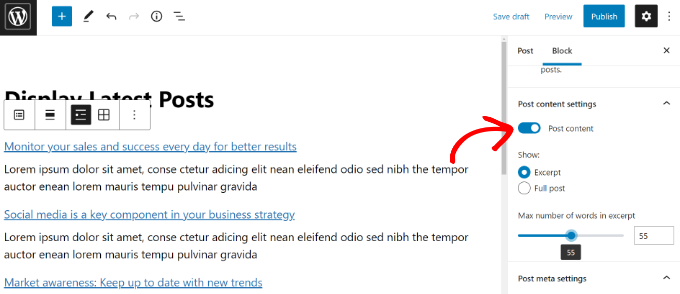
Finally, click the ‘Publish’ button at the top to store your settings. Now, some of your recent posts will still be displayed on the home page to ensure that users spend more time on your website.
For more information, you can see our tutorial on how to display recent posts in WordPress.
We hope this tutorial helped you learn how to create a separate page for blog posts in WordPress. You may also want to learn how to add custom post status for blog posts in WordPress or check out our list of the best related posts plugins for WordPress.
If you liked this article, then please subscribe to our YouTube Channel for WordPress video tutorials. You can also find us on Twitter and Facebook.





David Lim
Before I even read one of your articles, everything seems so difficult. But then somehow the dice turn and it gets easier. I think this should be my new business bible.
Dayo Olobayo
I’ve been blogging on WordPress for years but never bothered creating a separate page for posts. Figured it was too much work. But after reading this tutorial, I realized it only takes a few minutes. Wish I had done it sooner! My blog looks so much cleaner and more professional now.
Ismet Fitri
I would love if wpbeginner would share how you design your archive page. It looks so cool! Seeking for some help from your awesome team!
WPBeginner Support
For the moment we use our theme which is custom designed but for easy ways to customize your theme you can take a look at page builders like the ones we list in our article below!
https://www.wpbeginner.com/beginners-guide/best-drag-and-drop-page-builders-for-wordpress/
Admin
Steven Baldwin
Followed your instructions for creating static homepage and blog posts. However, when I made the changes in the settings>reading I forgot to click on homepage. Hence, no static homepage, can I correct this so I have a separate page from my blogs.
Thank you
WPBeginner Support
If we understand the question correctly, you should be able to go back into your settings and set your static home page so your blog posts are on a separate page.
Admin
John
Hi, what if i have multiple archive post pages? but wordpress only has 1 post page to assign. Which one do i assign? or shall i leave it blank?
WPBeginner Support
Your posts archive page would list every post on your site. If you wanted to separate by category, you can add links to the category in your menu and WordPress will generate an archive page for that category.
Admin
Tracey
Struggled to combine static pages and a blog. Couldn’t find a clear how to – until now. Finally fixed it. Thanks!
WPBeginner Support
Glad our guide could help
Admin
Gwyneth Llewelyn
Much, much easier than I thought. Thank you so much!
WPBeginner Support
Glad our guide was helpful
Admin
Mirta
Nice guide and thanks for help!
Now I managed my blog as I wanted to!
WPBeginner Support
Glad our guide was helpful
Admin
Bernice
My WordPress site is not displaying my blog posts on the blog page… Even after I set the blog page to post page… Please help..
WPBeginner Support
The most common reasons would be you would either need to clear your caching or check with your specific theme’s support to see if there is a theme-specific setting hiding the posts.
Admin
Ron Gladden
Much appreciated, I wasn’t asking google the right question but finally, I found your blog and solved my problem in 1 minute that I was working on for 2 hours. Thanks!
WPBeginner Support
Glad our guide could help
Admin
Chris
THANK YOU! Somehow my blog page stopped populating posts and I found that all I had to do was update my Reading settings to make my blog page my posts page. Thanks!
WPBeginner Support
Glad our guide was helpful
Admin
Sandi
Thanks it’s very helpful. But can you make the post slug following the blog?
for example.my blog post will be example.com/blog
can we make the new post and show the slug like this “example.com/blog/new-post” instead of “example.com/new-post” ?
WPBeginner Support
You would set that up in your permalinks which we cover in our guide below:
https://www.wpbeginner.com/wp-tutorials/how-to-create-custom-permalinks-in-wordpress/
Admin
Odysseas
Hi, I want my subdomain which is a blog to be added to the bottom menu.
WPBeginner Support
To do that you would want to create a custom menu and add that as a menu widget for what it sounds like you’re wanting to do.
Admin
Sheetal Pawar
if i am Posting 10 blogs per page then how can i distinguish between 2 post i mean how can i add the border so that the user will understand where the 2nd post starts
WPBeginner Support
Your theme’s styling should style the title of the post and some themes add separators for you.
Admin
Rachelle Partee
Hello!! How do you have different posts on different pages? For example I would like to have the blog page and a photography page with different posts.
WPBeginner Support
You could either use category pages like we do to separate our posts:
https://www.wpbeginner.com/beginners-guide/how-to-add-navigation-menu-in-wordpress-beginners-guide/
Another option would be to create a custom post type for your photography:
https://www.wpbeginner.com/wp-tutorials/how-to-create-custom-post-types-in-wordpress/
Admin
Chip
I am building a site in which I would like blog posts to go to one page, and podcasts go to another page.
Is that possible?
Thanks.
WPBeginner Support
You could create categories and add those categories to your menu which would add posts from those specific categories to those pages. Another more complex option would be to create a custom post type for your podcasts:
https://www.wpbeginner.com/wp-tutorials/how-to-create-custom-post-types-in-wordpress/
Admin
Tracey M Edwards
I have my Blog set as a Blog page. I’m having difficulty with the padding around the graphic for my Blog. When I move the slider on Blog Title Style, nothing changes around the graphic.
Thank you!
Tracey
WPBeginner Support
For the styling of your site, we would first recommend reaching out to the support for your specific theme to see if they have a built-in option for what you’re wanting or if it is a hiccup with the theme itself.
Admin
Liton Biswas
I followed all the steps. I created two pages. One is for home and another is for blog.
After that I went to setting > reading and set those pages properly. My home page is showing properly but the post page isn’t show my posts.
WPBeginner Support
You would want to ensure your posts are published and you’ve cleared any caching on your site for the most common reasons
Admin
Review Dunk
I am posting my new blog in my WordPress site but it doesn’t show in the blog site
WPBeginner Support
If the posts are published then you may want to try clearing your cache as well as the other recommendations in our guide below:
https://www.wpbeginner.com/wp-tutorials/how-to-fix-wordpress-website-not-updating-right-away/
Admin
Taylor Mills
Is there a way to have the blog posts listed on the home page AND the blog page??
WPBeginner Support
You could use one of the methods in our article below for what you’re wanting:
https://www.wpbeginner.com/wp-tutorials/how-to-display-recent-posts-in-wordpress
Admin
daniel
the problem is that when I configure the homepage settings to static homepage some of my built in theme features are not displaying such as my homepage slider which only shows if I configure settings to latest posts.
WPBeginner Support
You would want to reach out to your theme’s support and they would be able to help with allowing that feature on other pages.
Admin
Ken
I followed “Put The Blog Page Link to Your Website’s Navigation Menu” . All steps are right . Why i click the “blog” menu ,it comes out blank . But when i preview it on admin panel , it is ok .
WPBeginner Support
You may want to try clearing all of your caching on your site for the most common reason for that type of issue.
Admin
Nozie
Thank you so much you helped me in ways I can’t describe after being stuck ffor days. My problem now is that I can’t see an option to view my new Blog page as full width, which is what I’d like to do. It still shows the post plus widgets on the side.
WPBeginner Support
You would want to check with your theme’s support to see if your theme has a full-width template.
Admin